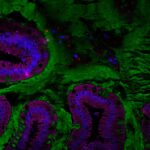Link to Pubmed [PMID] – 27855208
Link to DOI – 10.1371/journal.ppat.1005987
PLoS Pathog 2016 Nov; 12(11): e1005987
Pseudomonas aeruginosa is an opportunistic pathogen causing severe infections often characterized by robust neutrophilic infiltration. Neutrophils provide the first line of defense against P. aeruginosa. Aside from their defense conferred by phagocytic activity, neutrophils also release neutrophil extracellular traps (NETs) to immobilize bacteria. Although NET formation is an important antimicrobial process, the details of its mechanism are largely unknown. The identity of the main components of P. aeruginosa responsible for triggering NET formation is unclear. In this study, our focus was to identify the main bacterial factors mediating NET formation and to gain insight into the underlying mechanism. We found that P. aeruginosa in its exponential growth phase promoted strong NET formation in human neutrophils while its NET-inducing ability dramatically decreased at later stages of bacterial growth. We identified the flagellum as the primary component of P. aeruginosa responsible for inducing NET extrusion as flagellum-deficient bacteria remained seriously impaired in triggering NET formation. Purified P. aeruginosa flagellin, the monomeric component of the flagellum, does not stimulate NET formation in human neutrophils. P. aeruginosa-induced NET formation is independent of the flagellum-sensing receptors TLR5 and NLRC4 in both human and mouse neutrophils. Interestingly, we found that flagellar motility, not flagellum binding to neutrophils per se, mediates NET release induced by flagellated bacteria. Immotile, flagellar motor-deficient bacterial strains producing paralyzed flagella did not induce NET formation. Forced contact between immotile P. aeruginosa and neutrophils restored their NET-inducing ability. Both the motAB and motCD genetic loci encoding flagellar motor genes contribute to maximal NET release; however the motCD genes play a more important role. Phagocytosis of P. aeruginosa and superoxide production by neutrophils were also largely dependent upon a functional flagellum. Taken together, the flagellum is herein presented for the first time as the main organelle of planktonic bacteria responsible for mediating NET release. Furthermore, flagellar motility, rather than binding of the flagellum to flagellum-sensing receptors on host cells, is required for P. aeruginosa to induce NET release.


